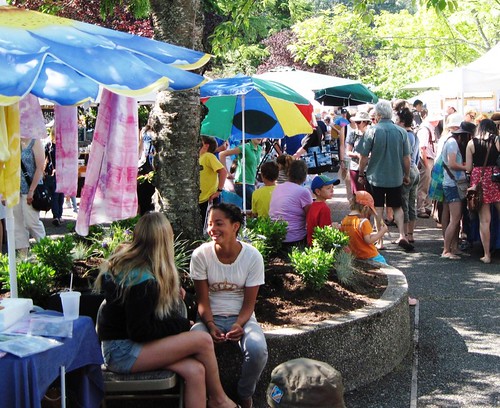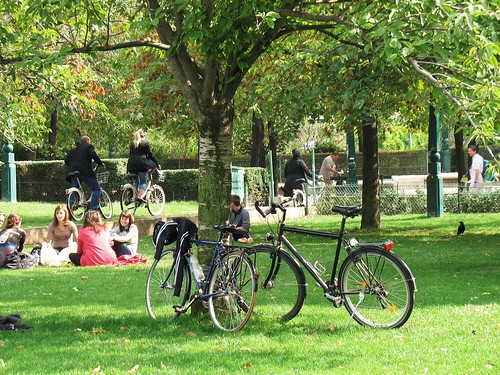Great city characteristics make us happier. Unless they don't.

Posted May 8, 2012 at 1:24PM
I’ve been looking at some research reports, and confirming that some of the qualities associated with great urbanism – good public transit; easy access to cultural activities, recreation and shops; connectedness – are associated positively with human happiness. I first reported (“The Environmental Building Blocks of Urban Happiness”) on a study reaching just those conclusions back in early February. Others found the study as well, concluding that residents of “beautiful, well-designed cities” are happier than those living in suburbs. It would seem to follow, unless we’re talking about a suburb that also has good transit, places of connection, and easy access to cultural activities, recreation and shops.
I’ve been following this topic for some time, because I believe that factors we generally think of as “subjective” can be every bit as important to fostering great, sustainable places as those that we can measure objectively. Of course, researchers being researchers, we try to measure them anyway (Seattle’s city council president on that city’s Happiness Initiative: “Measuring the subjective happiness or well-being levels of Seattle residents is an important tool . . .”), and I suppose it was just a matter of time before someone came up with a ranking. Indeed, earlier this year The Daily Beast measured a number of factors they believed make people happy, concluding in a widely-publicized story that residents of Washington, DC were the happiest in America, followed by residents of Boulder, San Francisco, San Jose, and Ann Arbor.
I would certainly like to believe that the same urban factors that make cities environmentally more functional and sustainable also make their residents happier. But not all the research lines up with that conclusion.
For example, last October Eric Jaffe wrote in Atlantic Cities that some research suggests that rural and suburban places produce more “subjective well-being” than do urban environments:
“In a recent paper published in the journal Urban Geography, Brian Berry and Adam Okulicz-Kozaryn contend that statistical data show a clear urban-rural happiness gradient — in other words, as they move from small town to suburb to city, they find a gradual decrease in subjective well-being . . .
“Their primary resource is the General Social Survey, a broad sweep of social information collected regularly since 1972. By mapping responses to the G.S.S. question on happiness with data on place of residence,
the researchers find that, between 1972 and 2008, ‘happiness has been lowest in the nation's largest cities and has consistently been at its highest levels in small towns and rural areas.’”
Jaffe points out, however, that other research contradicts those conclusions, or at least muddies them significantly.
Still another study – this one involving a bit of self-selection, since its data were generated by use of an iPhone app – finds that none of the above is true, since nature is what really produces a good mood:
“George MacKerron has been asking people about their happiness levels a few times a day for several years now. Using an iPhone app called Mappiness, he's built a citizen-science experiment where people are the sensors. ‘The data I'm using is [sic] specifically collected by people,’ he says.
“After installing the app, you're asked to confirm a few bits of demographic information and then rate your happiness, relaxation level, and sleepiness on a trio of sliding scales. Responses are tied to geolocation, and so MacKerron can work out the surroundings in which the responses are given in.
“The results pinpoint coasts as the place where people are happiest, followed by mountains, moors, woodland and grassland. Urban areas come right at the bottom of the list.”
MacKerron concedes that his methodology has some shortcomings, but nonetheless believes (as do I) that people’s subjective self-ratings are truer indicators of happiness than more easily quantified external information (The Daily Beast’s findings were based in part on things like a city’s weather and rates of employment and income).
The tilt toward nature as mood-enhancer is certainly consistent with findings related to biophilia, the word used first by E.O. Wilson to describe that humans have an intrinsic emotional need to connect with nature. A Montreal study found, for example, that students walking through an arboretum scored better on memory and mood indicia than a control group walking on city streets.
It’s hard to know exactly what to take away from all these findings, collectively messy at best. I lack the time and resources to study the subjects thoroughly and attempt to discover how the findings might be reconciled. But I do have some instincts about it all: For our well-being, we need places – including lively city environments, but perhaps also including rural and suburban ones – that foster positive human interaction and opportunities for cultural and social enrichment; but we also need to soften our people environments with nature and with beauty.
MacKerron’s findings, interestingly, go beyond the physical characteristics of one’s environment. For example, “the top activities associated with unhappiness include being ill in bed, waiting for something, and being at work.” I think we can probably agree on those.
Related posts:
- The environmental building blocks of urban happiness (February 2, 2012)
- What does 'the pursuit of happiness' mean for communities? (June 29, 2011)
- Why we love the places we love - what the research says (November 24, 2010)
- Constructing a city around the concept of happiness (March 5, 2010)
- Great short video on greening smart growth with living nature (August 17, 2009)
Move your cursor over the images for credit information.
Please also visit NRDC’s Sustainable Communities Video Channel.


